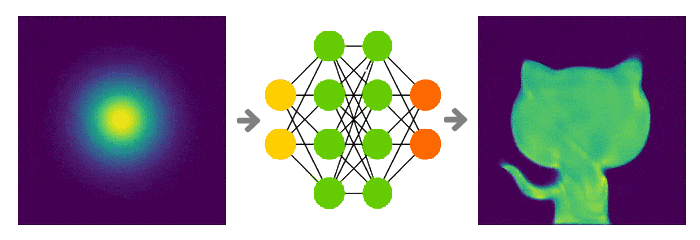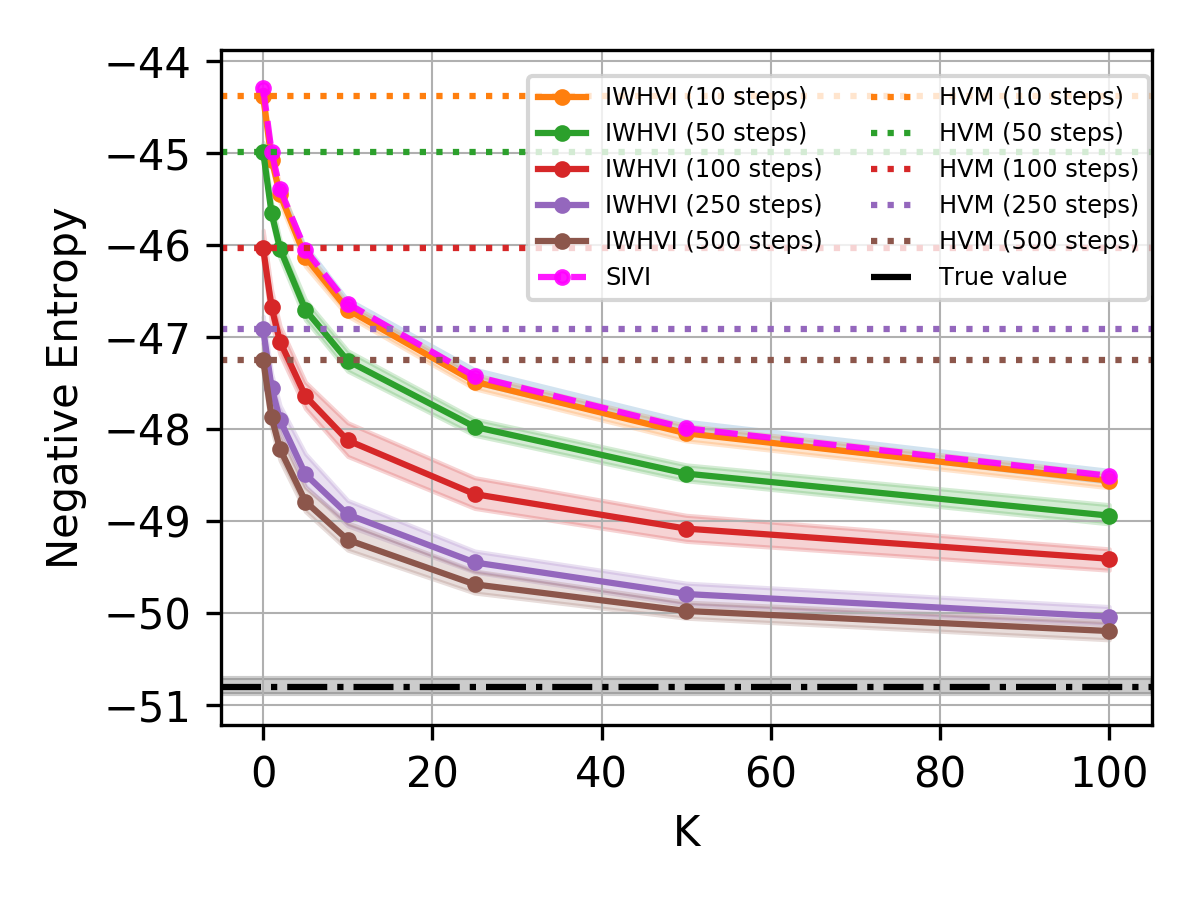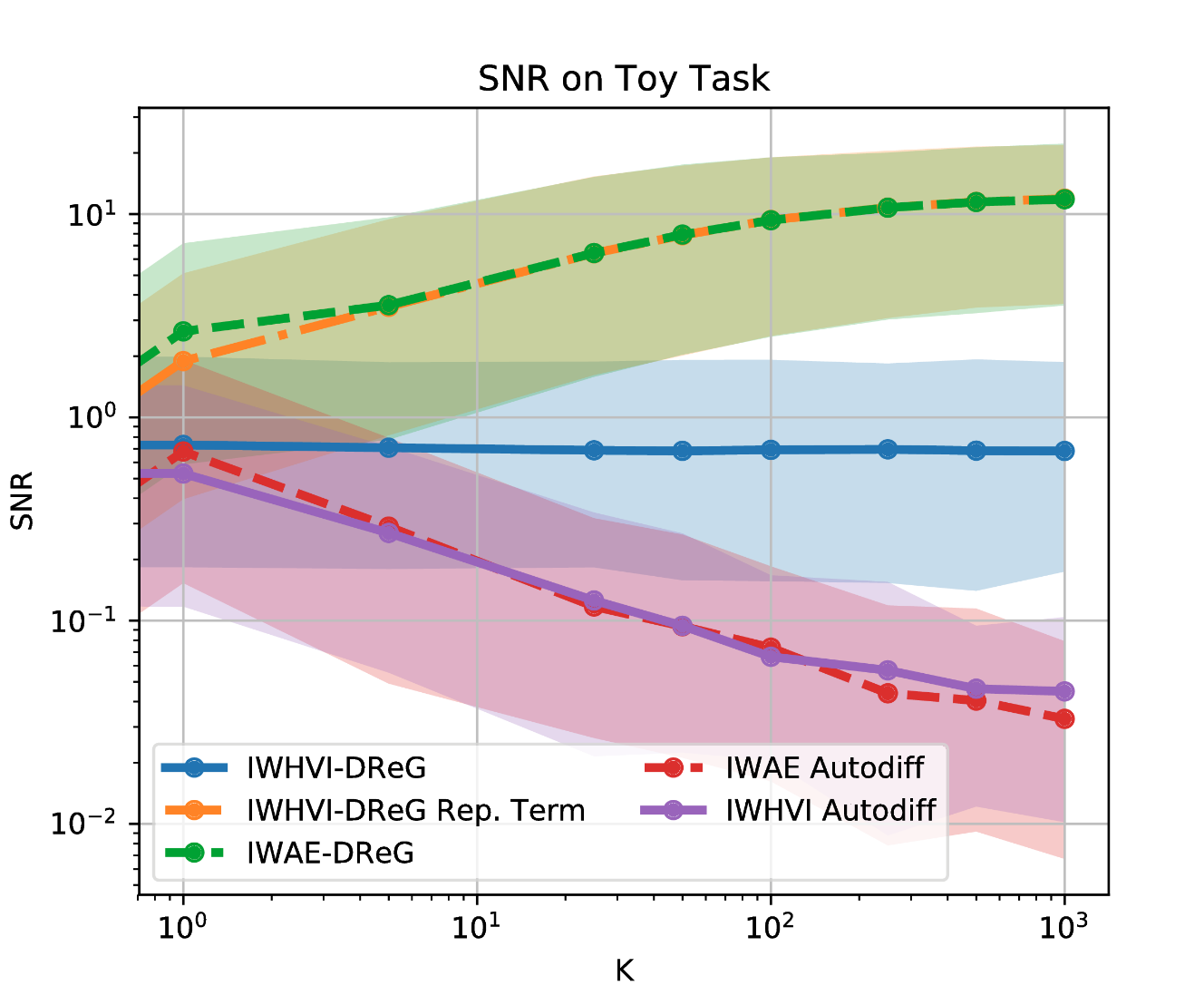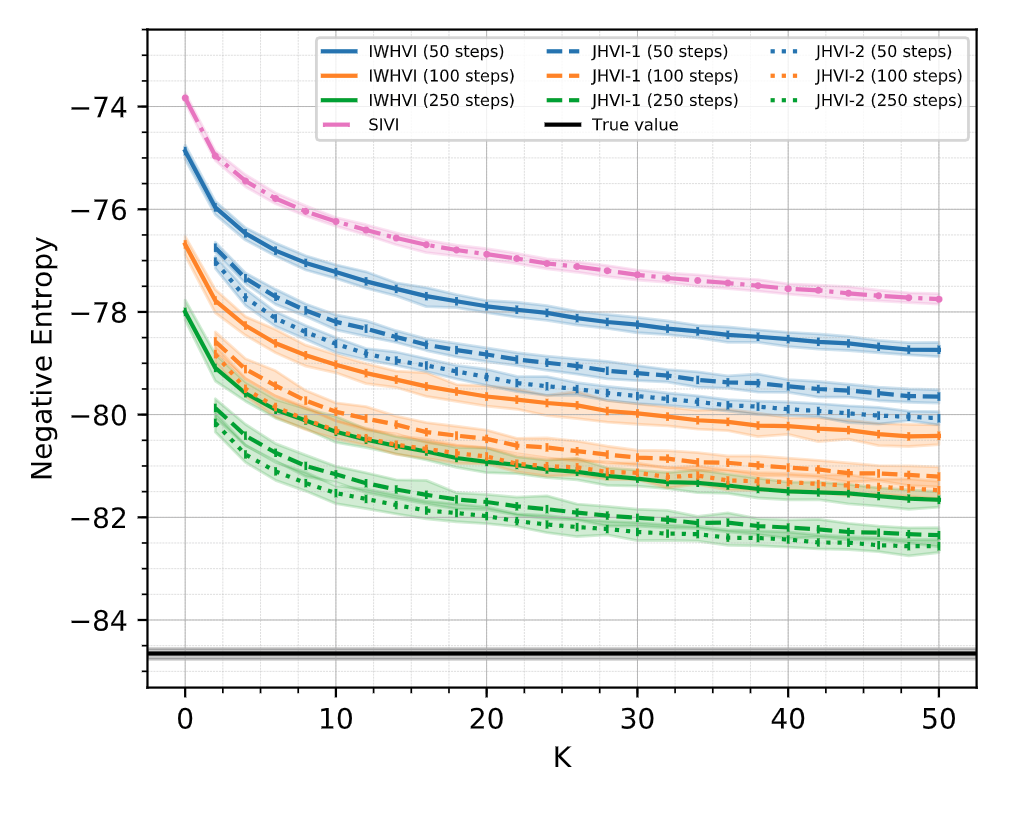Importance Weighted Hierarchical Variational Inference
Variational Inference
- Suppose you're given a latent variable model, parametrized by \(\theta\): $$ p_\theta(x) = \mathbb{E}_{p(z)} p_\theta(x|z) $$
- Marginal log-likelihood is intractable, we thus resort to a lower bound: $$ \log p_\theta(x) \ge \mathbb{E}_{q_\phi(z|x)} \log \frac{p_\theta(x, z)}{q_\phi(z \mid x)} =: \text{ELBO} $$
- Tightness of the bound is controlled by KL divergence between \(q_\phi(z|x)\) and the true posterior \( p_\theta(z|x) \): $$ \log p_\theta(x) - \text{ELBO} = D_{KL}(q_\phi(z|x) \mid\mid p_\theta(z | x)) $$ $$ \text{ELBO} = \log p_\theta(x) - D_{KL}(q_\phi(z | x) \mid\mid p_\theta(z | x)) $$
- Optimizing the ELBO w.r.t. \(\phi\) leads to improving the proposal \(q_\phi(z|x)\), hence the approximate posterior
- Optimizing w.r.t. \(\theta\) leads to a combination of increase in marginal log-likelihood and decrease in gap, making the true posterior and the model simpler
Variational Expressivity
- Variational distributions \(q_\phi(z|x)\) regularize the model, simple choices prevent the model \(p_\theta(x, z)\) from having complicated dependence structure
-
Standard VAE[1] has a fully factorized Gaussian proposal
- Parameters are generated by an encoder aka an inference network
- Neural Networks amortize the inference, and do not increase expressiveness
- Gaussian proposal with full covariance matrix is still Gaussian
- Can we leverage neural networks' universal approximation properties?

Neural Samplers as Proposals
- Huston, we have a problem: we can sample such random variables, but can't evaluate output's density $$ \large \text{ELBO} := \mathbb{E}_{\color{green} q_\phi(z|x)} \log \frac{p_\theta(x,z)}{\color{red} q_\phi(z|x)} $$
- There's been a huge amount of work on the topic
- Invertible transformations with tractable Jacobians (Normalizing Flows)
- Theoretically appealing and shown to be very powerful
- Might require a lot of parameters, can't do abstraction
- Methods that approximate the density ratio with a critic network
- Allow for fully implicit prior and proposal, handy in incremental learning
- Approximate nature breaks all bound guarantees
- Give bounds on the intractable \( \log q_\phi(z|x) \)
- Preserve the guarantees, but depend on bound's tightness
Hierarchical Proposals
- From now on we will be considering Hierarchical Proposal of the form $$ q_\phi(z|x) = \int q_\phi(z | \psi, x) q_\phi(\psi | x) dz $$ Assume both distributions under the integral are easy to sample from and are reparametrizable
- To keep the guarantees we need a lower bound on the ELBO: $$ \text{ELBO} = \mathbb{E}_{q_\phi(z|x)} \left[ \log p_\theta(x,z) - {\color{red} \log q_\phi(z|x)} \right] \; \ge \; ??? $$
- Equivalently, we need an upper bound on the intractable term \(\log q_\phi(z|x)\)
- Standard variational bound would give a lower bound (leading to an upper bound on ELBO) 😞 $$ \log q_\phi(z|x) \ge \mathbb{E}_{\tau_\eta(\psi | x, z)} \log \frac{q(z, \psi | x)}{\tau_\eta(\psi|x,z)}, $$ $$\text{ELBO} \le \mathbb{E}_{q_\phi(z|x)} \mathbb{E}_{\tau_\eta(\psi|x,z)} \log \frac{p_\theta(x, z) \tau_\eta(\psi | x, z)}{q_\phi(z, \psi|x)} \stackrel{\not \ge}{\not \le} \log p_\theta(x) $$ where \(\tau_\eta(\psi | x, z)\) is an auxiliary variational distribution with parameters \(\eta\)
Variational Upper Bound
- Take a closer look at the obtained upper bound on ELBO, it's easy to make it a lower bound
- Theorem: $$ \mathbb{E}_{q_\phi(z|x)} \mathbb{E}_{q_\phi(\psi|x,z)} \log \frac{p_\theta(x, z) \tau_\eta(\psi | x, z)}{q_\phi(z, \psi|x)} \le \text{ELBO} \le \log p_\theta(x) $$
- Proof: Apply log and Jensen's inequality to this identity: $$ \mathbb{E}_{q_\phi(\psi | z, x)} \frac{\tau_\eta(\psi \mid x, z)}{q_\phi(z, \psi |x)} = \frac{1}{q_\phi(z|x)} \quad \Rightarrow \quad \mathbb{E}_{q_\phi(\psi | z, x)} \log \frac{\tau_\eta(\psi \mid x, z)}{q_\phi(z, \psi |x)} \le \log \frac{1}{q_\phi(z|x)}$$
- That this gives a variational upper bound on marginal log-likelihood: $$ \log q_\phi(z|x) \le \mathbb{E}_{\color{blue} q_\phi(\psi|x, z)} \log \frac{q_\phi(z,\psi|x)}{\tau_\eta(\psi|x,z)} $$
- Notice the similarity with the standard variational lower bound $$ \log q_\phi(z|x) \ge \mathbb{E}_{\color{blue} \tau_\eta(\psi|x, z)} \log \frac{q_\phi(z,\psi|x)}{\tau_\eta(\psi|x,z)} $$
- Merge \(q_\phi(z) q_\phi(\psi|x,z)\) into \(q_\phi(z, \psi|x)\), then factorize as \(q_\phi(\psi|x) q_\phi(z|\psi, x)\)
Q.E.D.
Hierarchical Variational Inference
- So we just put VAE into the VAE $$ \mathbb{E}_{q_\phi(z, \psi|x)} \log \frac{p_\theta(x, z) \tau_\eta(\psi | x, z)}{q_\phi(z, \psi|x)} \le \log p_\theta(x) $$ Where the proposal \(q_\phi(z|x)\) is a (conditional) latent variable model itself!
- Another way to look at this bound is as if we augmented the generative model \(p_\theta(x, z)\) with an auxiliary distribution \(\tau_\eta(\psi|x,z)\) and then performed joint variational inference for \(z, \psi\)
- Thus the name auxiliary variables[2] aka hierarchical variational model[3]
- However, now we have a similar problem, the gap with the ELBO is $$ \text{ELBO} - \mathbb{E}_{q_\phi(z, \psi|x)} \log \frac{p_\theta(x, z) \tau_\eta(\psi | x, z)}{q_\phi(z, \psi|x)} = D_{KL}(q_\phi(\psi|x,z) \mid\mid \tau_\eta(\psi|x,z)) $$
- So even though \(q_\phi(z|x)\) is allowed to be a complicated hierarchical model, this bound favors simple models with \(q_\phi(\psi|z,x)\) being close to \(\tau_\eta(\psi|x,z)\)
- Besides, \(q_\phi(z, \psi|x)\) might disregard the auxiliary r.v. \(\psi\) and degenerate to a simple parametric model, indicated by \(q_\phi(\psi|x, z) = q_\phi(\psi|x)\)
Multisample Lower Bounds Recap
- The standard ELBO admits tightening through usage of multiple samples: $$ \text{ELBO} \le \text{IW-ELBO}_M := \mathbb{E}_{q_\phi(z_{1:M}|x)} \log \frac{1}{M} \sum_{m=1}^M \frac{p_\theta(x, z_m)}{q_\phi(z_m|x)} \le \log p_\theta(x) $$
- Known as Importance Weighted Variational Inference[4,5]
- Can be interpreted[5] as a refining procedure that improves the standard proposal \(q_\phi(z|x)\), turning it into \(\hat{q}_\phi^M\):
- Sample M i.i.d. \(z\) from the \(q_\phi(z|x)\)
- For each one compute its ELBO \(w_k = \log p(x, z_m) - \log q_\phi(z_m)\)
- Sample \(h \sim \text{Categorical}(\text{softmax}(w)) \)
- Return \(z_h\)
- Except... the ELBO with such proposal would be hard to compute and optimize over, so the IWAE objective turns out to be a lower bound on that: $$ \text{ELBO}[q_\phi] \le \text{IW-ELBO}_M[q_\phi] \le \text{ELBO}[\hat{q}_\phi^M] $$
- Requires \(M\) high-dimensional decoder \(p_\theta(x, z_m)\) evaluations
Multisample Upper Bounds?
- Can we tighten the variational upper bound using multiple samples?
- Sure! $$ \mathbb{E}_{q_\phi(\psi_{1:M} | z, x)} \frac{1}{M} \sum_{m=1}^M \frac{\tau_\eta(\psi \mid x, z)}{q_\phi(z, \psi |x)} = \frac{1}{q_\phi(z|x)} \quad $$ Thus $$ \mathbb{E}_{q_\phi(\psi_{1:M} | z, x)} \log \frac{1}{M} \sum_{m=1}^M \frac{\tau_\eta(\psi \mid x, z)}{q_\phi(z, \psi |x)} \le \log \frac{1}{q_\phi(z|x)}$$ And $$ \log q_\phi(z|x) \le \mathbb{E}_{q_\phi(\psi_{1:M} | z, x)} \log \frac{1}{\frac{1}{M} \sum_{m=1}^M \frac{\tau_\eta(\psi \mid x, z)}{q_\phi(z, \psi |x)}} $$
- But is this bound practical? Hell, no.
- It requires sampling from the true posterior not once, but \(M\) times!
- A variational Harmonic estimator, which is known[6] to behave very poorly
A case of Semi-Implicit VI
- Curiously, Semi-Implicit Variational Inference[7] proposed the following lower bound on the ELBO: $$ \mathbb{E}_{q_\phi(z, \psi_0|x)} \mathbb{E}_{\color{blue} q_\phi(\psi_{1:K}|x)} \log \frac{p_\theta(x, z)}{\color{blue} \frac{1}{K+1} \sum_{k=0}^K q_\phi(z|x, \psi_k)} \le \text{ELBO}[q_\phi] \le \log p_\theta(x) $$
- Equivalently, $$ \log q_\phi(z|x) \le \mathbb{E}_{q_\phi(\psi_0|x, z)} \mathbb{E}_{\color{blue} q_\phi(\psi_{1:K}|x)} \log \frac{1}{K+1} \sum_{k=0}^K q_\phi(z|\psi_k, x) $$
- Recall the lower variational multisample bound: $$ \log q_\phi(z|x) \ge \mathbb{E}_{\color{blue} \tau_\eta(\psi_{1:K}|z,x)} \log \frac{1}{K} \sum_{k=1}^K \frac{q_\phi(z,\psi_k|x)}{\tau_\eta(\psi_k|x,z)} $$or, for \(\tau_\eta(\psi|x,z) = q_\phi(\psi|x)\): $$ \log q_\phi(z|x) \ge \mathbb{E}_{\color{blue} q_\phi(\psi_{1:K}|x)} \log \frac{1}{K} \sum_{k=1}^K q_\phi(z|\psi_k, x) $$
These two look suspiciously similar!
Are we onto something?
- So, we know that the following is an upper bound for at least one particular choice of \(\tau_\eta(\psi|x,z)\) $$ \mathbb{E}_{q_\phi(\psi_0|x, z)} \mathbb{E}_{\color{red} \tau_\eta(\psi_{1:K}|z,x)} \log \frac{1}{K+1} \sum_{k=0}^K \frac{q_\phi(z,{\color{red}\psi_k}| x)}{\color{red} \tau_\eta(\psi_k \mid x, z)} \quad\quad (1) $$
- Moreover, for \(K=0\) it reduces to the already discussed HVM bound, also an upper bound: $$ \log q_\phi(z | x) \le \mathbb{E}_{q_\phi(\psi_0|x, z)} \log \frac{q_\phi(z,\psi_0| x)}{\tau_\eta(\psi_0 \mid x, z)} $$
- Finally, for \(\tau_\eta(\psi|x,z) = q_\phi(\psi|x,z)\) we exactly recover \(\log q_\phi(\psi|x,z)\)
Given all this evidence, it's time to question ourselves: Is this all just a coincidence? Or, is the (1) indeed a multisample \(\tau\)-variational upper bound on the marginal log-density \(\log q_\phi(z|x)\)?
Multisample Variational Upper Bound Theorem
Theorem: for \(K \in \mathbb{N}_0 \), any* \(q_\phi(z, \psi|x)\) and \(\tau_\eta(\psi|x,z)\) denote $$ \mathcal{U}_K := \mathbb{E}_{q_\phi(\psi_0|x, z)} \mathbb{E}_{\tau_\eta(\psi_{1:K}|z,x)} \log \frac{1}{K+1} \sum_{k=0}^K \frac{q_\phi(z,\psi_k| x)}{\tau_\eta(\psi_k \mid x, z)}$$Then the following holds
- \(\mathcal{U}_K \ge \log q_\phi(z|x)\)
- \(\mathcal{U}_K \ge \mathcal{U}_{K+1} \)
- \(\lim_{K \to \infty} \mathcal{U}_K = \log q_\phi(z|x) \)
Proof: we will only prove the first statement by showing that the gap between the bound and the marginal log-density is equal to some KL divergence
Proof of Multisample Variational Upper Bound Theorem
Proof: consider the gap $$ \mathbb{E}_{q_\phi(\psi_0|x, z)} \mathbb{E}_{\tau_\eta(\psi_{1:K}|z,x)} \log \tfrac{1}{K+1} \sum_{k=0}^K \frac{q_\phi(z,\psi_k| x)}{\tau_\eta(\psi_k \mid x, z)} - \log q_\phi(z|x)$$
Multiply and divide by \(q_\phi(\psi_0|x,z) \tau_\eta(\psi_{1:K}|x,z)\) to get $$ \mathbb{E}_{q_\phi(\psi_0|x, z)} \mathbb{E}_{\tau_\eta(\psi_{1:K}|z,x)} \log \frac{q_\phi(\psi_0|x, z) \tau_\eta(\psi_{1:K}|z,x)}{\frac{q_\phi(\psi_0|x, z) \tau_\eta(\psi_{1:K}|z,x)}{\tfrac{1}{K+1} \sum_{k=0}^K \frac{q_\phi(\psi_k| z,x)}{\tau_\eta(\psi_k \mid x, z)}}} $$
Subtract the log $$ \mathbb{E}_{q_\phi(\psi_0|x, z)} \mathbb{E}_{\tau_\eta(\psi_{1:K}|z,x)} \log \tfrac{1}{K+1} \sum_{k=0}^K \frac{q_\phi(\psi_k| z,x)}{\tau_\eta(\psi_k \mid x, z)} $$
Which is exactly the KL divergence $$ D_{KL}\left(q_\phi(\psi_0|x, z) \tau_\eta(\psi_{1:K}|z,x) \mid\mid \frac{q_\phi(\psi_0|x, z) \tau_\eta(\psi_{1:K}|z,x)}{\tfrac{1}{K+1} \sum_{k=0}^K \frac{q_\phi(\psi_k| z,x)}{\tau_\eta(\psi_k \mid x, z)} }\right)$$
Is the second argument even a distribution?
For the KL to enjoy non-negativity and be 0 when distributions match, we need the second argument to be a valid probability density. Is it? $$ \omega_{q,\tau}(\psi_{0:K}|x,z) := \frac{q_\phi(\psi_0|x, z) \tau_\eta(\psi_{1:K}|z,x)}{\tfrac{1}{K+1} \sum_{k=0}^K \frac{q_\phi(\psi_k| z,x)}{\tau_\eta(\psi_k \mid x, z)} }$$
We'll show it by means of symmetry:
$$ \int \frac{q_\phi(\psi_0|x, z) \tau_\eta(\psi_{1:K}|z,x)}{\tfrac{1}{K+1} \sum_{k=0}^K \frac{q_\phi(\psi_k| z,x)}{\tau_\eta(\psi_k \mid x, z)} } d\psi_{0:K} = \int \frac{\frac{q_\phi(\psi_0|x, z)}{\tau_\eta(\psi_0|x, z)} \tau_\eta(\psi_{0:K}|z,x)}{\tfrac{1}{K+1} \sum_{k=0}^K \frac{q_\phi(\psi_k| z,x)}{\tau_\eta(\psi_k \mid x, z)} } d\psi_{0:K} =$$
However, there's nothing special in the choice of the 0-th index, we could take any \(j\) and the expectation wouldn't change. Let's average all of them: $$= \int \frac{\frac{q_\phi(\psi_j|x, z)}{\tau_\eta(\psi_j|x, z)} \tau_\eta(\psi_{0:K}|z,x)}{\tfrac{1}{K+1} \sum_{k=0}^K \frac{q_\phi(\psi_k| z,x)}{\tau_\eta(\psi_k \mid x, z)} } d\psi_{0:K} = \frac{1}{K+1} \sum_{j=0}^K \int \frac{\frac{q_\phi(\psi_j|x, z)}{\tau_\eta(\psi_j|x, z)} \tau_\eta(\psi_{0:K}|z,x)}{\tfrac{1}{K+1} \sum_{k=0}^K \frac{q_\phi(\psi_k| z,x)}{\tau_\eta(\psi_k \mid x, z)} } d\psi_{0:K}$$
Q.E.D.
$$ = \int \frac{\frac{1}{K+1} \sum_{j=0}^K \frac{q_\phi(\psi_j|x, z)}{\tau_\eta(\psi_j|x, z)} \tau_\eta(\psi_{0:K}|z,x)}{\tfrac{1}{K+1} \sum_{k=0}^K \frac{q_\phi(\psi_k| z,x)}{\tau_\eta(\psi_k \mid x, z)} } d\psi_{0:K} = \int \tau_\eta(\psi_{0:K}|z,x) d\psi_{0:K} = 1$$
Toy Example
Lets see how our variational upper bound compares with prior work.
- Consider standard D-dim. Laplace distribution as a scale-mixture of Normals: $$ q(z) = \int \prod_{d=1}^D \mathcal{N}(z^{(d)}|0, \psi^{(d)}) \text{Exp}(\psi^{(d)} \mid \tfrac{1}{2}) d\psi^{(1:D)} $$
- To test bound's behavior in high dimensions we won't be using the factorization property.
- As a proposal \(\tau(\psi \mid z)\) we will use a Gamma distribution whose parameters are generated by a neural network with three hidden layers of size \(10 D\)
- We give an upper bound on negative differential entropy: $$ \mathbb{E}_{q(z)} \log q(z) \le \mathbb{E}_{q(z, \psi_0)} \mathbb{E}_{\text{Gamma}(\psi_{1:K}|\alpha(z), \beta(z))} \log \tfrac{1}{K+1} \sum_{k=0}^K \tfrac{\prod_{d=1}^D \mathcal{N}(z^{(d)}|0, \psi_k^{(d)})\text{Exp}(\psi_k^{(d)}|\tfrac{1}{2})}{\prod_{d=1}^D \text{Gamma}(\psi_k^{(d)} |\alpha(z)_d, \beta(z)_d)} $$
- We initialize auxiliary inference network s.t. untrained network produces \(\alpha(z) \approx 1\) and \(\beta(z) \approx \tfrac{1}{2}\), collapsing into the \(\text{Exp}(\tfrac{1}{2})\) prior, and giving us the SIVI bound
Toy Example

Multisample Variational Sandwich Bounds on KL
Corollary: for the case of two hierarchical distributions \(q(z) = \int q(z, \psi) d\psi \) and \(p(z) = \int p(z, \zeta) d\zeta \), we can give the following multisample variational bounds on KL divergence:
$$ \large D_{KL}(q(z) \mid\mid p(z)) \le \mathbb{E}_{q(z, \psi_0)} \mathbb{E}_{\tau(\psi_{1:K}|z)} \mathbb{E}_{\nu(\zeta_{1:L}|z)} \log \frac{\tfrac{1}{K+1} \sum_{k=0}^K \frac{q(z, \psi_k)}{\tau(\psi_k|z)}}{\frac{1}{L} \sum_{l=1}^L \frac{p(z, \zeta_l)}{\nu(\zeta_l|z)} } $$
$$ \large D_{KL}(q(z) \mid\mid p(z)) \ge \mathbb{E}_{q(z)} \mathbb{E}_{\tau(\psi_{1:K}|z)} \mathbb{E}_{p(\zeta_0|z)} \mathbb{E}_{\nu(\zeta_{1:L}|z)} \log \frac{\tfrac{1}{K} \sum_{k=1}^K \frac{q(z, \psi_k)}{\tau(\psi_k|z)}}{\frac{1}{L+1} \sum_{l=0}^L \frac{p(z, \zeta_l)}{\nu(\zeta_l|z)} } $$
Where \(\tau(\psi|z)\) and \(\nu(\zeta|z)\) are variational approximations to \(q(\psi|z)\) and \(p(\zeta|z)\), correspondingly
Note: actually, variational distributions in the lower and upper bounds optimize different divergences, thus technically they should be different
ELBO with Hierarchical Proposal
- We can now combine KL's upper bound with ELBO to obtain a lower bound: $$ \mathbb{E}_{q(z, \psi_{0}|x)} \mathbb{E}_{\tau_\eta(\psi_{1:K}|x,z)} \log \frac{p_\theta(x, z)}{\frac{1}{K+1} \sum_{k=0}^K \frac{q_\phi(z, \psi_{k}|x)}{\tau_\eta(\psi_{k}|z, x)} } \le \log p_\theta(x) $$ Called Importance Weighted Hierarchical Variational Inference bound
- Semi-Implicit Variational Inference bound obtained for \(\tau(\psi|x,z) = q_\phi(\psi|x) \): $$ \mathbb{E}_{q(z, \psi_{0}|x)} \mathbb{E}_{q_\phi(\psi_{1:K}|x)} \log \frac{p_\theta(x, z)}{\frac{1}{K+1} \sum_{k=0}^K q_\phi(z | \psi_{k}, x) } \le \log p_\theta(x) $$
-
Hierarchical Variational Models bound obtained by setting \(K = 0\): $$ \mathbb{E}_{q(z, \psi|x)} \log \frac{p_\theta(x, z)}{ \frac{q_\phi(z, \psi|x)}{\tau_\eta(\psi|z, x)} } = \mathbb{E}_{q(z, \psi|x)} \log \frac{p_\theta(x, z) \tau_\eta(\psi|z, x)}{ q_\phi(z, \psi|x) } \le \log p_\theta(x) $$
- The Joint bound obtained by implicitly setting \(\tau_\eta(\psi|x,z) = p_\theta(\psi|x,z)\): $$ \mathbb{E}_{q(z, \psi|x)} \log \frac{p_\theta(x, z)}{ \frac{q_\phi(z, \psi|x)}{p_\theta(\psi|z, x)} } = \mathbb{E}_{q(z, \psi|x)} \log \frac{p_\theta(x, z, \psi)}{ q_\phi(z, \psi|x) } \le \log p_\theta(x) $$
Comparison to Prior Bounds
- SIVI allows for unknown mixing density \(q_\phi(\psi|x)\) as long as we can sample
- \(q_\phi(\psi|x)\) is assumed to be implicit and reprametrizable, therefore we can reformulate the model to have an explicit "prior": $$ q_\phi(z|x) = \int q_\phi(z|\psi, x) q_\phi(\psi|x) d\psi \quad\Rightarrow\quad q_\phi(z|x) = \int q_\phi(z|\psi(\varepsilon; \phi), x) q(\varepsilon) d\varepsilon $$
- We thus can assume we know \(\psi\)'s density in most cases
- IWHVI needs to make an extra pass of \(z\) through \(\tau\)'s network to generate the \(\tau\) distribution, however it's dominated by multiple \(q_\phi(z, \psi_k|x)\) evaluations, needed for both SIVI and IWHVI
- SIVI's poor choice of \(q_\phi(\psi|x)\) as an auxiliary variational approximation of \(q_\phi(\psi|x,z)\) leads to samples \(\psi\) that are uninformed about the current \(z\) and miss the high probability area of \(\psi|z\), essentially leading to random guesses
- HVM also uses the targeted auxiliary variational approximation, but lacks multisample tightening, leading to heavier penalization for complex \(q_\phi(\psi|x,z)\)
Multisample ELBO with Hierarchical Proposal
- So far we used multiple samples of \(\psi\) to tighten the \(\log q_\phi(z|x)\) bound
- But we can also use multiple samples of \(z\) to tighten the \(\log p_\theta(x)\) bound $$ \mathbb{E}_{q(z_{1:M}, \psi_{1:M,0}|x)} \mathbb{E}_{\tau_\eta(\psi_{1:M,1:K}|x,z_{1:M})} \log \frac{1}{M} \sum_{m=1}^M \frac{p_\theta(x, z_m)}{\frac{1}{K+1} \sum_{k=0}^K \frac{q_\phi(z_m, \psi_{mk}|x)}{\tau_\eta(\psi_{mk}|z_m, x)} } \le \log p_\theta(x) $$ Called Doubly Importance Weighted Hierarchical Variational Inference bound
- This bound requires \(O(M + M K)\) samples of \(\psi\)
- Interestingly, SIVI allows for sample reuse, needing only \(O(M+K)\) samples: $$ \mathbb{E}_{q(z_{1:M}, \psi_{1:M}|x)} \mathbb{E}_{q_\phi(\psi_{M+1:M+K}|x)} \log \frac{1}{M} \sum_{m=1}^M \frac{p_\theta(x, z_m)}{\frac{1}{M+K} \sum_{k=1}^{M+K} q_\phi(z_m| \psi_{k},x) } \le \log p_\theta(x) $$
- Same trick cannot be applied to the DIWHVI
- One possible solution is to consider a multisample-conditioned proposal \(\tau_\eta(\psi|z_{1:M})\) that is invariant to any permutation of \(z_{1:M}\)
VAE Experiment
- We used the DIWHVI bound: $$ \mathbb{E}_{q(z_{1:M}, \psi_{1:M,0}|x)} \mathbb{E}_{\tau_\eta(\psi_{1:M,1:K}|x,z_{1:M})} \log \frac{1}{M} \sum_{m=1}^M \frac{p_\theta(x, z_m)}{\frac{1}{K+1} \sum_{k=0}^K \frac{q_\phi(z_m, \psi_{mk}|x)}{\tau_\eta(\psi_{mk}|z_m, x)} } \le \log p_\theta(x) $$
- For training we used \(M=1\) and gradually increased \(K\) from 1 to 50
- For evaluation we used \(M=5000\) and \(K=100\)
- For SIVI we trained \(\tau_\eta(\psi|x,z)\) separately after the model was trained
- \(p_\theta(x|z)\) was generated by a neural network with two hidden layers of size \(H\)
- \(q_\phi(z|x, \psi)\) was generated by a neural network with two hidden layers of size \(H\), but in addition \(\psi\) was concatenated with all intermediate representations
- \(q(\psi|x)\) was standard Normal distribution, independent of \(x\)
- \(\tau_\eta(\psi|x,z)\) was generated by a neural network with two hidden layers of size \(H\) and took concatenated \((x, z)\) vector as input
VAE Experiment
| Method | MNIST | OMNIGLOT |
|---|---|---|
| AVB+AC | −83.7 ± 0.3 | — |
| IWHVI | −83.9 ± 0.1 | −104.8 ± 0.1 |
| SIVI | −84.4 ± 0.1 | −105.7 ± 0.1 |
| HVM | −84.9 ± 0.1 | −105.8 ± 0.1 |
| VAE+RealNVP | −84.8 ± 0.1 | −106.0 ± 0.1 |
| VAE+IAF | −84.9 ± 0.1 | −107.0 ± 0.1 |
| VAE | −85.0 ± 0.1 | −106.6 ± 0.1 |
Test log-likelihood on dynamically binarized MNIST and OMNIGLOT with 2 std. interval
The Signal-to-Noise Ratio Problem of Tighter Bounds
- For IWAE it was shown[8] that the quality (as measured by the signal-to-noise ratio) of the gradients w.r.t. \(\theta\) increases with \(M\), but SNR of the gradients w.r.t. \(\phi\) decreases.
- Increasing \(M\) increases noise in \(\nabla_\phi\), undermining the inference network
- The same problem, if exists in our case, might prevent us from learning good \(\tau\), diminishing our advantage over SIVI
- Luckily, it was recently shown[9] that the source of this high variance is a hidden REINFORCE-like term in the (reparametrized!) gradient estimator, and it can be removed by a second application of the reparametrization trick.
- The same reasoning can be applied to our bound. It does, indeed, contain a REINFORCE-like term in the reparametrized gradient estimator, which hurts the SNR, but can be similarly removed by the 2nd reparametrization
The Signal-to-Noise Ratio Problem of Tighter Bounds

Debiasing
- IWAE bound can be seen as a biased evidence \(\log p_\theta(x)\) approximator. The bias can can be shown to be of order \(O(1/M)\): $$ \log p_\theta(x) - \mathbb{E}_{q_\phi(z_{1:M}|x)} \log \frac{1}{M} \sum_{m=1}^M \frac{p_\theta(x, z_m)}{q_\phi(z_m)} = \frac{\alpha_1}{M} + O\left(\tfrac{1}{M^2}\right) $$
- One can apply Jackknife to reduce the bias to \(O(1/M^2)\)
- By applying Jackknife D times one gets[10] bias of order \(O(1/M^{D+1})\)
- However, such "debiased" estimator is not guaranteed to be a lower bound
- Same trick is possible for the IWHVI to get tighter estimates of the marginal log-likelihood that tend to overestimate \(\log p_\theta(x)\)
Debiasing Experiment

Conclusion
- We presented a variational multisample lower bound on the intractable ELBO for the case of a hierarchical proposal \(q_\phi(z|x)\)
- The bound turned out to generalize many previous methods
- Most importantly, it bridges HVM and SIVI
- We showed that the proposed bound improves upon its special cases
- It is a tighter upper bound on the marginal log-density \(\log q_\phi(z|x)\)
- It reduces regularizational effect of the auxiliary variational distributions of both SIVI and HVM, allowing for more expressive marginal \(q_\phi(z|x)\)
- It is closely related to IWAE, and many results apply to the IWHVI as well
- It benefits from double reparametrization to improve gradients
- The gap can be reduced by means of the Jackknife
- IWHVI can be combined with IWAE to obtain an even tighter lower bound on the marginal log-likelihood \(\log p_\theta(x)\)
- ... it is not yet fully understood
References
- Auto-Encoding Variational Bayes by Diederik P Kingma and Max Welling
- Auxiliary Deep Generative Models by Lars Maaløe, Casper Kaae Sønderby, Søren Kaae Sønderby, Ole Winther
- Hierarchical Variational Models by Rajesh Ranganath, Dustin Tran, David M. Blei
- Importance Weighted Autoencoders by Yuri Burda, Roger Grosse, Ruslan Salakhutdinov
- Importance Weighting and Variational Inference by Justin Domke and Daniel Sheldon
- The Harmonic Mean of the Likelihood: Worst Monte Carlo Method Ever by Radford Neal
- Semi-Implicit Variational Inference by Mingzhang Yin and Mingyuan Zhou
- Tighter Variational Bounds are Not Necessarily Better by Tom Rainforth, Adam R. Kosiorek, Tuan Anh Le, Chris J. Maddison, Maximilian Igl, Frank Wood, Yee Whye Teh
- Doubly Reparameterized Gradient Estimators for Monte Carlo Objectives by George Tucker, Dieterich Lawson, Shixiang Gu, Chris J. Maddison
- Debiasing Evidence Approximations: On Importance-weighted Autoencoders and Jackknife Variational Inference by Sebastian Nowozin